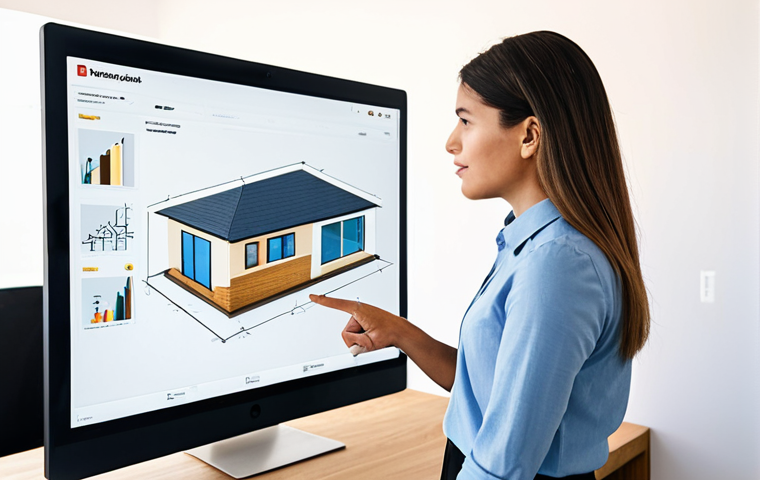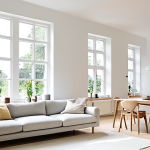Building someone’s dream space isn’t just about lines on a blueprint; it’s profoundly about people. I’ve personally experienced how the most brilliant design can crumble if the client relationship isn’t nurtured with the same care as the structure itself.
It’s often said that a successful project is 50% design and 50% managing expectations, a truth I’ve felt deep in my bones over the years. The nuances of communication, the unspoken desires, and those moments of true connection—they all weave into the fabric of a project’s success.
It’s a delicate dance, really, balancing artistic vision with practical needs and emotional ties. And honestly, in today’s fast-paced world, this dance has become even more intricate.
I’ve witnessed firsthand how clients, armed with endless Pinterest boards and HGTV-inspired fantasies, sometimes struggle to articulate their actual needs, making our role as translators more critical than ever.
We’re seeing a massive shift towards hyper-personalization and sustainability, with clients demanding not just a house, but a lifestyle, often enhanced by smart tech integrations.
This means architects now need to be experts in more than just structures; we’re becoming psychologists, tech consultants, and even budget whisperers.
The biggest challenge? Bridging that gap between a client’s aspirational vision and the practical realities of budget and buildability, especially when unforeseen issues pop up – and trust me, they always do.
I remember one project where the client suddenly decided they wanted an indoor koi pond mid-construction, something entirely out of scope, and navigating that conversation without damaging our relationship felt like walking a tightrope.
It required empathy, clear communication, and a shared commitment to finding a viable solution. Future trends suggest AI might soon assist in predicting client preferences and even potential friction points, offering us tools to preemptively manage expectations and tailor designs even more precisely, turning potential conflicts into collaborative triumphs.
But ultimately, it will always come down to the human element, the genuine connection you forge. Let’s delve deeper into this below.
Beyond the Blueprint: Understanding Client Psychology

Building someone’s dream space isn’t just about lines on a blueprint; it’s profoundly about people. I’ve personally experienced how the most brilliant design can crumble if the client relationship isn’t nurtured with the same care as the structure itself.
It’s often said that a successful project is 50% design and 50% managing expectations, a truth I’ve felt deep in my bones over the years. The nuances of communication, the unspoken desires, and those moments of true connection—they all weave into the fabric of a project’s success.
It’s a delicate dance, really, balancing artistic vision with practical needs and emotional ties. And honestly, in today’s fast-paced world, this dance has become even more intricate.
I’ve witnessed firsthand how clients, armed with endless Pinterest boards and HGTV-inspired fantasies, sometimes struggle to articulate their actual needs, making our role as translators more critical than ever.
We’re seeing a massive shift towards hyper-personalization and sustainability, with clients demanding not just a house, but a lifestyle, often enhanced by smart tech integrations.
This means architects now need to be experts in more than just structures; we’re becoming psychologists, tech consultants, and even budget whisperers.
The biggest challenge? Bridging that gap between a client’s aspirational vision and the practical realities of budget and buildability, especially when unforeseen issues pop up – and trust me, they always do.
I remember one project where the client suddenly decided they wanted an indoor koi pond mid-construction, something entirely out of scope, and navigating that conversation without damaging our relationship felt like walking a tightrope.
It required empathy, clear communication, and a shared commitment to finding a viable solution. Future trends suggest AI might soon assist in predicting client preferences and even potential friction points, offering us tools to preemptively manage expectations and tailor designs even more precisely, turning potential conflicts into collaborative triumphs.
But ultimately, it will always come down to the human element, the genuine connection you forge.
1. Decoding the Unspoken: Reading Between the Lines
I’ve learned that truly understanding a client goes far beyond their initial brief. It’s about listening not just to what they say, but to what they *don’t* say, observing their reactions, and picking up on subtle cues.
I recall a young couple who insisted they wanted a minimalist, ultra-modern home, yet their eyes would always light up when we discussed salvaged wood features or a cozy reading nook.
It turned out their perception of “modern” was deeply rooted in the aesthetics they saw on Instagram, but their underlying desire was for comfort and warmth.
It took several deeper conversations, almost like therapy sessions, for them to articulate that desire for a space that felt both clean and inviting. My job then shifted from simply designing a structure to creating a living environment that resonated with their true selves, not just their aspirational online persona.
This process of deeply engaging with their emotional landscape, beyond the functional requirements, truly sets a project on a path to profound success and personal satisfaction for everyone involved.
2. Empathy as Your Architectural Compass: Stepping into Their Shoes
You simply cannot overstate the power of empathy in this field. I’ve walked into countless initial consultations where clients are a mix of excitement, apprehension, and often, a touch of overwhelm.
They’re pouring their life savings, their hopes, and their dreams into this venture. My approach has always been to put myself squarely in their shoes.
What anxieties might they have about costs? What if the design doesn’t feel right? How will this impact their daily life?
I remember one client, a single mother, who had meticulously saved for years to build her dream home. She was terrified of going over budget, but also secretly longed for a specific type of kitchen.
By understanding her fears and her quiet aspirations, I was able to present a design that thoughtfully balanced her budget constraints with clever value engineering, allowing for that dream kitchen without breaking the bank.
That moment, when her eyes welled up with relief and joy, was a powerful reminder that our work is fundamentally about improving lives.
Navigating the Digital Dreamscape: Pinterest, HGTV, and Reality
In an era saturated with visual inspiration, our clients arrive at our doorsteps armed not just with ideas, but with fully formed, often unrealistic, digital dream boards.
Pinterest, Instagram, and renovation shows like HGTV have democratized design, giving everyone a taste of what’s possible, but rarely do they expose the practical limitations, hidden costs, or engineering complexities involved.
I’ve seen this play out countless times. A client brings in a picture of a breathtaking cantilevered pool deck overlooking the ocean, not realizing their plot is flat, landlocked, and half the size required.
It’s a delicate dance to manage these lofty aspirations without deflating their excitement entirely. We are not just designers; we are dream translators, tasked with bridging the chasm between fantastical images and tangible realities.
The key lies in respectful education, offering innovative alternatives that capture the spirit of their vision while remaining grounded in the project’s parameters.
This requires a profound depth of knowledge, not just in design and construction, but in the art of gentle persuasion and realistic expectation setting.
It’s a frustrating but ultimately rewarding challenge when you see the light bulb go off, and they grasp the practicalities, shifting from disappointment to excited collaboration.
1. When Inspiration Collides with Reality: Gentle Redirection
The challenge isn’t just that clients have grand ideas; it’s that those ideas often come without a price tag or an understanding of local zoning laws.
I vividly recall a client who was utterly fixated on a glass-walled, indoor-outdoor living space that would have been magnificent – if it weren’t for the fact their property was in a high-wind zone and required robust, expensive structural reinforcement that would have shattered their budget.
Instead of simply saying “no,” which can shut down a creative conversation, I brought them to a site where a similar, more structurally sound, but equally beautiful solution had been implemented.
Showing them a tangible example, explaining the “why” behind the limitations, and offering an equally stunning but feasible alternative allowed them to see the possibilities within their constraints.
It transformed a potential point of friction into a collaborative problem-solving session, ultimately leading to a design they loved and could actually afford to build.
2. Setting the Stage: The Initial Consultation as an Educational Forum
I’ve learned that the first meeting isn’t just for us to gather requirements; it’s a crucial opportunity to gently educate clients on the realities of the design and construction process.
I like to call it “pre-framing expectations.” I openly discuss the potential for unforeseen challenges, the importance of a contingency budget, and how inspiration from a perfectly staged TV show might differ from the lived reality of a family home.
I also show them case studies of past projects, highlighting both the successes and the hurdles we overcame. This proactive approach helps to temper expectations early on, creating a foundation of trust and transparency.
It shifts their mindset from passive dreamers to active, informed participants in the journey, making future difficult conversations about budget overruns or design compromises much smoother because they’re already mentally prepared for the complexities inherent in such a massive undertaking.
The Art of Transparent Communication: Building Bridges, Not Walls
If there’s one cornerstone to successful architectural projects, it’s undeniably transparent and continuous communication. I’ve witnessed brilliant designs falter simply because lines of communication broke down, leading to misunderstandings, frustration, and ultimately, a breakdown in trust.
It’s not just about conveying information; it’s about fostering an environment where clients feel heard, understood, and genuinely part of the process.
I remember a particularly stressful period on a residential project where an unexpected material shortage threatened to delay the entire build. My immediate reaction was to inform the client, not just with the bad news, but with a clear action plan and alternative solutions.
We scheduled an emergency call, laid out all the options, explained the pros and cons of each, and allowed them to be part of the decision-making process.
That open dialogue, even when delivering challenging news, solidified their trust in our team. They saw us as proactive partners, not just service providers.
This level of honesty, even when it’s uncomfortable, cultivates a robust relationship that can weather any storm.
1. Proactive Updates: No Surprises, Only Solutions
One of my non-negotiables in client management is proactive communication. It’s far better to anticipate potential issues and inform the client early, rather than waiting for problems to escalate.
I’ve found that even small updates, like “The revised permits are still awaiting approval, but we expect them by Friday,” can significantly reduce client anxiety.
Conversely, nothing erodes trust faster than radio silence followed by sudden, bad news. I once took over a project where the previous architect had kept the client completely in the dark about escalating costs.
When the final bill came, it was a massive shock. My approach would have been to implement weekly or bi-weekly check-ins, detailing progress, potential roadblocks, and budget updates.
Even if there’s nothing new to report on a given week, a quick email saying “All on track, no changes this week!” can provide immense peace of mind. It shows you’re on top of things, thinking of them, and actively managing their investment.
2. Setting Communication Ground Rules: Defining How We Connect
Before any real design work begins, I make it a point to establish clear communication protocols. This means discussing preferred methods (email, phone, in-person meetings), response times, and the best way to handle urgent matters.
I recall a client who would call at 11 PM with design tweaks they’d thought of just before bed. While I appreciate enthusiasm, clear boundaries are essential for sustainable workflow and mental health.
We gently established that non-urgent communication should happen via email during business hours, and important design discussions would be scheduled for dedicated meeting times.
This small adjustment significantly improved efficiency and reduced stress for everyone involved. It wasn’t about being inaccessible; it was about ensuring that every interaction was productive and respected everyone’s time and boundaries, leading to clearer outcomes and fewer miscommunications.
Budgeting Brilliance: Aligning Aspirations with Financial Realities
Money talk is often the elephant in the room, but in architecture, it needs to be front and center, handled with grace, transparency, and unwavering honesty.
I’ve learned that the most successful projects aren’t necessarily the ones with the biggest budgets, but those where financial expectations are crystal clear from the outset.
I’ve seen the despair in a client’s eyes when their dream home turns into a financial nightmare because the architect failed to manage budget expectations.
It’s a profound responsibility to guide clients through this financial labyrinth, ensuring their aspirations align with their actual capacity to spend.
My personal approach is to introduce the budget conversation very early, not as a restrictive barrier, but as a framework that defines the possibilities.
We discuss not just the “build cost,” but the holistic financial picture: design fees, permits, landscaping, interior finishes, and even a contingency fund for the inevitable surprises.
This comprehensive approach prevents sticker shock down the line and empowers clients to make informed decisions.
1. The Value Engineering Conversation: Maximizing Every Dollar
Value engineering isn’t about cutting corners; it’s about smart design and strategic material selection to deliver the most impact within a given budget.
I often sit down with clients and present a tiered approach, showing them how different material choices or design complexities directly impact costs.
For example, a custom-built, curved staircase might be visually stunning, but a well-designed straight staircase can be equally elegant and significantly more budget-friendly.
I remember a project where the client desperately wanted high-end marble countertops, but their budget was tight. Instead of dismissing their desire, we explored alternatives like large-format porcelain tiles that mimicked marble’s look at a fraction of the cost, reserving their marble splurge for a smaller, high-impact area like a bathroom vanity.
This collaborative process allows clients to feel empowered, making informed decisions about where to invest their money to achieve the greatest personal value and aesthetic impact without compromising the overall vision.
2. Building in Contingency: Expecting the Unexpected
One of the most critical, yet often overlooked, aspects of budget management is the contingency fund. From my experience, unforeseen issues – a change in ground conditions, a sudden price hike in a key material, or a client-requested modification – are not “if,” but “when.” I always recommend a minimum 10-15% contingency on top of the estimated construction cost.
I recall a project where, during excavation, we discovered an unexpected rock formation that required specialized blasting equipment. Because we had factored in a contingency, the client wasn’t faced with a sudden, devastating bill.
Instead, it was an anticipated expenditure, managed calmly within the existing financial framework. Explaining this necessity upfront, showing historical data of typical project overruns, and emphasizing that it’s a safety net rather than a wasteful allocation, is crucial for securing client buy-in and preventing future financial anxiety.
Unexpected Hurdles & Agile Solutions: The Project Rollercoaster
Every architect who tells you a project goes perfectly smoothly is either lying or has only built miniature models. The reality is that construction is a messy, dynamic, and often unpredictable process.
Unforeseen site conditions, supplier delays, permitting challenges, and mid-project client requests are not exceptions; they are the norm. I’ve personally navigated everything from surprise archaeological finds that halted work for weeks to a sudden shift in local building codes that required an entire redesign of a roof structure.
These moments can feel like a punch to the gut, creating immense pressure. However, what truly defines a project’s success, and indeed, an architect’s reputation, is not the absence of problems, but the agility and grace with which those problems are addressed.
It’s about pivoting quickly, finding creative solutions, and maintaining a calm, reassuring demeanor for your client, even when your internal alarm bells are ringing loudly.
1. Navigating Change Orders with Grace: Flexibility and Foresight
Client-initiated changes mid-construction are almost inevitable. It might be a sudden desire for a larger pantry or a different window style they saw at a friend’s house.
While these can be frustrating and costly, my approach is to view them as opportunities to further tailor the project to their evolving needs, provided they are managed correctly.
I remember a time when a client decided, halfway through framing, that they wanted to significantly enlarge their primary bedroom suite. Instead of shutting them down, we immediately assessed the structural implications, provided a clear cost estimate for the change, and discussed the timeline impact.
We laid out the pros and cons transparently. This collaborative approach, rather than simply presenting a “take it or leave it” change order, allowed them to make an informed decision, and ultimately, they were thrilled with the result, feeling fully in control of their dream home’s evolution, even with the added cost.
2. Problem-Solving as Partnership: Turning Obstacles into Opportunities
When genuine, unforeseen problems arise – like discovering an underground stream during excavation or a significant delay in receiving custom windows – my first instinct is to involve the client in the solution, not just present them with the problem.
I lay out the issue clearly, explain its implications, and then propose several viable solutions, detailing the costs and benefits of each. It’s about framing challenges as shared puzzles to solve together.
I recall a particularly complex foundation issue on a hillside property where an unexpected soil report meant we couldn’t proceed with the initial design.
Instead of panic, I called an emergency meeting with the client, our structural engineer, and the contractor. Together, we brainstormed, and within a few hours, we had devised an alternative foundation system that was not only structurally sound but also slightly more cost-effective.
That shared problem-solving experience deepened our bond and fostered an incredible sense of team, turning a potential disaster into a testament to collaborative resilience.
| Client Challenge | Architect’s Empathetic Strategy | Outcome |
|---|---|---|
| Unrealistic Budget | Early, transparent cost breakdowns; Value Engineering options; Phased construction planning. | Clients feel empowered, make informed choices, avoid sticker shock, project remains feasible. |
| Changing Vision Mid-Project | Structured change order process; Clear communication of cost/timeline impact; Visualizing changes. | Client feels heard, avoids costly mistakes, project evolves collaboratively, increased satisfaction. |
| Overwhelmed by Complexity | Simplified explanations; Regular, concise updates; Utilizing 3D renderings/models; Patient guidance. | Client feels supported, understands process, reduces anxiety, builds trust. |
| Emotional Attachment to Ideas | Deep listening; Offering “why not” explanations with alternatives; Focusing on core desires. | Client feels respected, accepts practical limitations, appreciates creative alternatives. |
The Human Element Endures: Forging Lasting Partnerships
Despite all the technological advancements and streamlined processes in architecture, the fundamental core of our profession remains deeply human. It’s about relationships, trust, and the profound satisfaction of helping someone realize a deeply personal dream.
I’ve found that the projects that bring the most joy and yield the most referrals aren’t necessarily the largest or the most visually stunning, but those where a genuine, lasting partnership was forged with the client.
It’s about being more than just a service provider; it’s about becoming a trusted advisor, a creative collaborator, and sometimes, even a friend. I remember attending the housewarming party for a family whose home I designed years ago.
Seeing them thrive in the space, hearing them talk about how perfectly it fit their lives, brought a profound sense of satisfaction that no award or publication could ever match.
That connection, that feeling of having genuinely impacted someone’s daily life for the better, is the enduring reward in this challenging but immensely gratifying field.
1. Beyond Project Completion: Nurturing Post-Handover Relationships
The client relationship shouldn’t end the moment the keys are handed over. I’ve made it a practice to follow up with clients a few months after completion, checking in to see how they’re settling into their new space, if any issues have arisen, or if they have any questions.
Sometimes it’s a quick phone call, other times a brief visit. I recall a client who had some minor issues with their smart home system a few weeks after moving in.
Because I had maintained contact, they felt comfortable reaching out immediately. I was able to connect them with the right installer to resolve it quickly, preventing what could have become a festering frustration.
This small gesture of continued care reinforces trust and often leads to invaluable word-of-mouth referrals. It transforms a transactional relationship into a long-term connection, fostering a loyal client base that values your genuine commitment to their satisfaction.
2. The Ripple Effect: Trust as the Ultimate Referral Generator
In the world of bespoke design and architecture, your reputation is your most valuable asset, and that reputation is built, brick by brick, on trust. When clients genuinely trust you, not just your design skills but your integrity and your commitment to their best interests, they become your most powerful advocates.
I’ve never actively pursued aggressive marketing campaigns; instead, my business has grown almost entirely through word-of-mouth referrals. I believe this is a direct result of prioritizing the client relationship above all else.
When you consistently deliver not just beautiful designs but also a seamless, respectful, and transparent experience, clients don’t just recommend you; they enthusiastically *sell* you to their friends, family, and colleagues.
They share their positive experiences, not just about the finished product, but about the journey itself – the ease of communication, the empathy shown, the problems elegantly solved.
This organic growth, fueled by genuine client satisfaction, is the most sustainable and rewarding business model there is.
Embracing Tomorrow: Tech, Sustainability, and the Future of Client Collaboration
The architectural landscape is constantly evolving, with new technologies and societal priorities shaping how we design and build. From AI-driven design tools to cutting-edge sustainable materials and increasingly sophisticated smart home integrations, the future promises even more intricate client needs and possibilities.
My personal journey has seen a dramatic shift from hand-drawn blueprints to immersive virtual reality walkthroughs with clients. This technological leap isn’t just about efficiency; it’s profoundly about enhancing the client experience, allowing them to visualize and interact with their future space in unprecedented ways.
As clients become more digitally savvy and environmentally conscious, our role as architects expands to include being guides through this exciting new frontier.
We’re not just designing structures; we’re crafting sustainable, tech-infused lifestyles, and the collaborative process is becoming richer, more interactive, and undeniably more complex.
1. AI as a Collaborative Partner: Augmenting Human Connection
While some fear AI might replace human designers, I see it as an incredible tool to augment our creative process and deepen client collaboration. Imagine being able to use AI to quickly generate hundreds of design iterations based on client preferences, or to predict potential structural issues before they even arise.
I’ve begun experimenting with AI tools that analyze client questionnaires and Pinterest boards to identify underlying aesthetic preferences and functional needs that even the client might not have articulated consciously.
This allows me to approach initial design concepts with a far more informed perspective, making the client feel incredibly understood from the very first sketch.
It frees up my time from repetitive tasks, allowing me to focus more on the truly human aspects of the job: the empathetic listening, the creative problem-solving, and the deep, personal connection that ultimately brings a dream to life.
It’s not about AI replacing me, but about AI making me a better, more insightful partner to my clients.
2. Designing for a Greener Tomorrow: Sustainable Aspirations Met with Expertise
Sustainability is no longer a niche request; it’s a fundamental expectation for many clients. They’re not just asking for an energy-efficient home; they’re inquiring about embodied carbon, water recycling systems, healthy material choices, and renewable energy integration.
This means architects must be more than just structural experts; we need to be environmental consultants, capable of translating complex green building principles into tangible, aesthetically pleasing, and financially viable solutions.
I remember a recent project where the client was passionate about passive house design but had a limited budget. It required extensive research and creative problem-solving to find affordable, locally sourced materials and integrate smart design strategies that maximized natural light and ventilation without breaking the bank.
Guiding them through the various certifications, explaining the long-term cost savings, and showcasing how their choices contributed to a healthier planet wasn’t just part of the job; it felt like a shared mission, aligning their values with our design expertise to create a truly meaningful home.
Wrapping Up
Ultimately, the blueprint of a successful architectural project isn’t merely lines on paper; it’s intricately drawn by the human connections we forge.
My journey has consistently reinforced that empathy, transparent communication, and genuine partnership are the true foundations upon which dreams are built.
It’s a continuous learning process, a delicate dance between vision and reality, always centered on understanding the unique individuals we serve. This approach, I’ve found, not only leads to breathtaking spaces but also cultivates enduring relationships, turning clients into advocates and projects into shared legacies.
Handy Insights for Your Next Project
1. Patience is a Virtue: Remember that clients are often making the largest financial and emotional investment of their lives. Their anxieties are valid, and a calm, empathetic approach goes a long way.
2. Over-communicate, Don’t Under-communicate: Even if there’s no major update, a quick “All on track this week!” email provides immense peace of mind and reinforces trust.
3. Budget First, Dreams Second: Establish clear financial expectations very early. It sets a realistic framework and prevents heartbreak or disappointment later in the process.
4. Embrace the Unexpected: Always factor in a contingency fund (typically 10-15%). Projects rarely go 100% to plan, and having a buffer saves stress for everyone when unforeseen issues arise.
5. Listen Beyond the Words: Pay close attention to body language, emotional cues, and underlying desires. Often, what clients *say* isn’t their deepest need; it’s your job to decode it.
Key Takeaways
Mastering client psychology is paramount in architecture. It requires deep empathy, transparent and proactive communication, realistic expectation setting (especially regarding budget and digital inspirations like Pinterest), and agile problem-solving. By prioritizing genuine human connection and trust, architects can navigate complex projects, turning potential hurdles into collaborative triumphs and consistently delivering spaces that truly resonate with clients’ lives, fostering satisfaction and long-term advocacy.
Frequently Asked Questions (FAQ) 📖
Q: Given the shift you described, how has the architect’s role truly changed beyond just drafting blueprints?
A: Oh, it’s monumental, truly. We’ve morphed from just being structural designers into something far more intricate. I’ve witnessed firsthand how clients, armed with endless Pinterest boards and HGTV-inspired fantasies, sometimes struggle to articulate their actual needs.
This makes our role as translators more critical than ever. We’re now becoming psychologists, trying to unearth those unspoken desires; tech consultants, because smart home integrations are no longer a luxury but an expectation; and even budget whisperers, because everyone dreams big but reality always sets in.
It’s not just about lines on a blueprint anymore; it’s about crafting a lifestyle, a feeling, and ensuring it aligns with their financial comfort, which, believe me, is often a tight squeeze.
Q: What do you find is the single biggest challenge in bridging a client’s aspirational vision with the practical realities of construction and budget?
A: The biggest challenge, without a shadow of a doubt, is managing that delicate tightrope walk between a client’s sky-high aspirational vision and the grounded realities of budget and buildability.
And trust me, unforeseen issues pop up – they always do. I remember one project where the client suddenly decided, mid-construction, they absolutely needed an indoor koi pond.
It was entirely out of scope, a curveball I hadn’t seen coming. Navigating that conversation without damaging our relationship felt like walking a tightrope.
It required a deep well of empathy, crystal-clear communication about the implications – the added costs, the structural changes, the timeline hit – and a shared commitment to finding a viable solution, even if it meant adjusting their initial dream.
It’s about being upfront, transparent, and always focused on collaborative problem-solving, even when things get unexpectedly wild.
Q: You mentioned
A: I potentially assisting in the future. Despite technological advancements, why do you believe the human element will always remain paramount in this field?
A3: While future trends suggest AI might indeed assist us in predicting client preferences or even potential friction points, offering tools to preemptively manage expectations and tailor designs with incredible precision, the ultimate truth remains: it will always come down to the human element.
AI can crunch data, analyze trends, and simulate outcomes, but it cannot feel, empathize, or build a genuine connection. It can’t understand the true emotional weight a client attaches to their dream home, the nuances of an unspoken sigh, or the joy in their eyes when they finally see their vision come to life.
Those moments of true connection, the shared commitment to overcoming obstacles, the delicate dance of balancing artistic vision with practical needs and emotional ties—those are inherently human.
You can’t automate trust, and you certainly can’t automate the art of transforming a house into a home, imbued with personal stories and dreams. That genuine connection you forge with a client, the empathy you bring to their deepest desires and fears – that’s irreplaceable.
📚 References
Wikipedia Encyclopedia
구글 검색 결과
구글 검색 결과
구글 검색 결과
구글 검색 결과
구글 검색 결과




